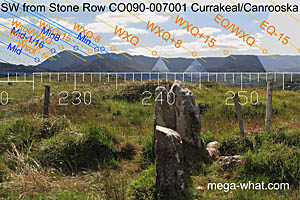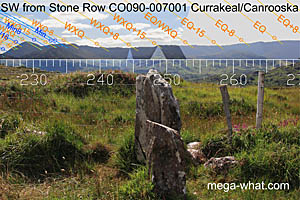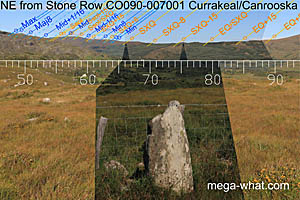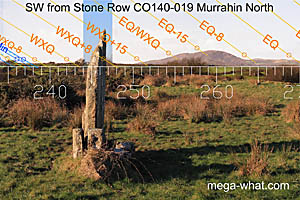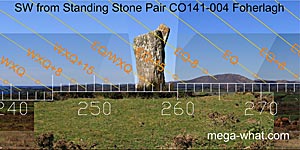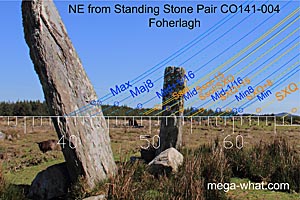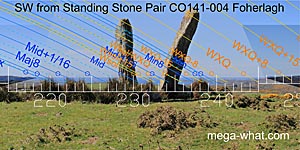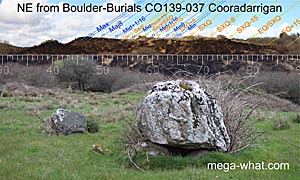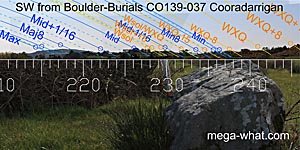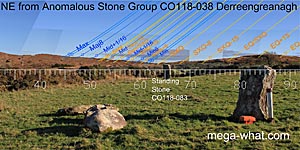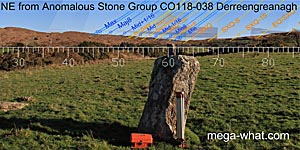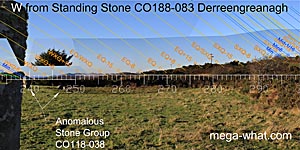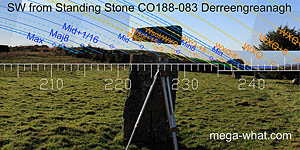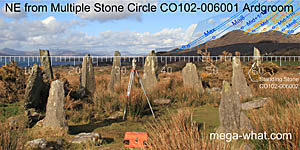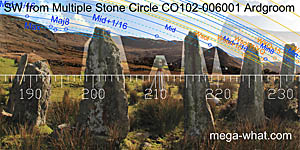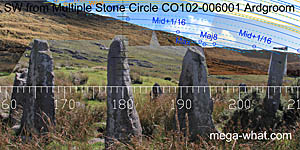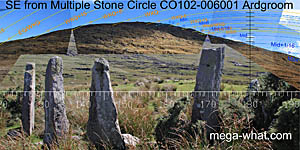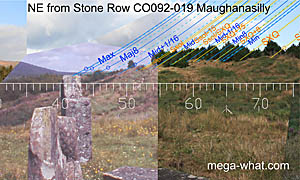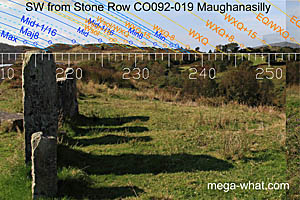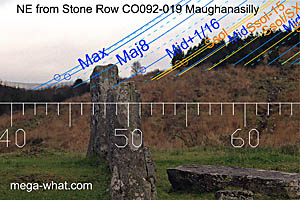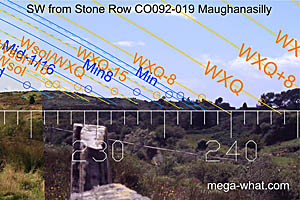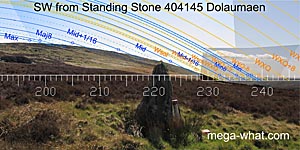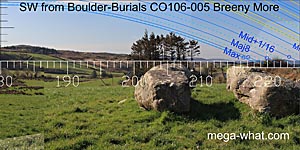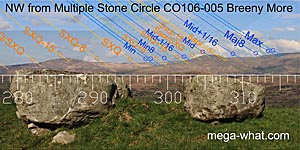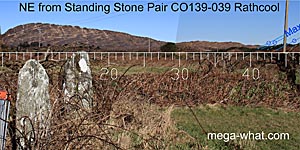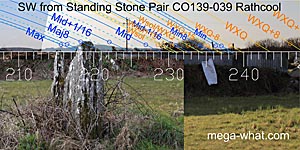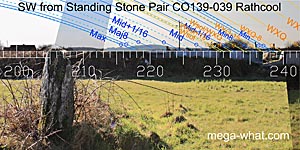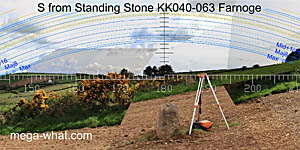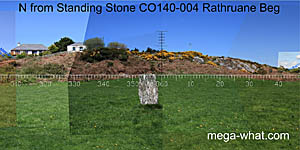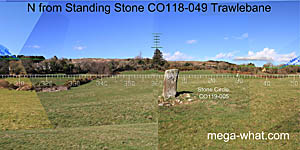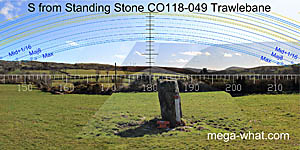All surveyed megalithic sites with recorded / recoverable axes.
Sorted by: Alignment Class | Location Name
Prehistoric monuments mark places where the whole horizon matches cyclical celestial patterns [statistics].
The astronomical meaning of megalithic alignments are thus more easily understood within the context of all round fit.
This survey data is from a mix of megalithic site types. Mostly Irish but some British; mostly bronze age but quite a few neolithic.
- For classification purposes these surveyed horizons have been divided into a small number of zones.
This classification is an overall one that considers all axes to be potentially bi-directional.
- Extreme is where sun and moon never rise or set but excludes the north-south axis of celestial rotation.
- Lunar is where lunistices
Lunistices are the most northerly and southerly moons of the month. The lunar equivalent of solstices. More.
occur but sun rises or sets do not.
- Solar is where sun rises or sets occur but lunistices do not.
- Solar / Lunar is where a lunistice zone overlaps with the outer regions of the sun's annual travels.
Alternatively one direction may be purely solar while the other is somewhere within a lunistice range.
- Note that these terms may well have other uses elsewhere.
- 89% of these surveyed monuments have axes that indicate directions of obvious importance to calendrical horizon astronomy.
- 11% have "extreme" axes but 7 of these 16 sites have an axis that bisects the space between a
major standstillLunistice positions vary cyclically over an 18.6 year period but
are fairly static for more than a year at either end of the range.
position and the north-south axis, making another 6% that become astronomically significant once understood.
- Thus, in this study, 94% of axial alignments are astronomically significant and just 6% have no explanation at this time.
There is a working theory concerning those few but more research is necessary.
- Of this sample (excluding the sixteen with extreme axes), thirty-seven are uni-directional and ninety-four are bi-directional.
- Orange Solar trajectories split the tropical year into 48 "Tweeks" (7.6 day mean) that are better regarded as quarter-months.
- Solid Blue Lunar lines split cyclical lunistice position variation into 16 periods of about 14 months each.
- Lunistices are the most northerly and southerly moons of the month [More].
- Also see Technical Notes on the Pictures
Class = Solar: Total 41 = 28%. Both axial directions indicate pure solar horizons where no
lunistices
Lunistices are the most northerly and southerly moons of the month. The lunar equivalent of solstices. More.
occur, or one direction does so while the other is beyond the entire luni-solar range.
Go to class= Solar/Lunar |
Lunar |
Extreme |
North / South
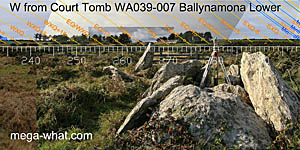
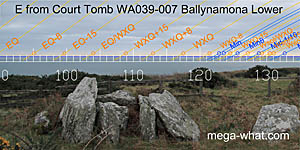 Ballynamona Court Tomb
Ballynamona Court Tomb:
This axis seems intended to indicate equinox / cross-quarter midpoints in both directions.

 Derreengreanagh Wedge Tomb
Derreengreanagh Wedge Tomb:
The ruinous state precludes an accurate assessment but reverse axis to the east is perhaps vaguely equinoctial.
To the west, a seemingly secure backstone suggests an axis more towards the equinox / winter cross-quarter midpoint.
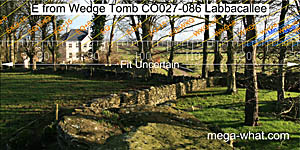
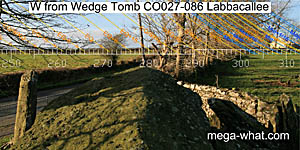 Labbacallee Wedge Tomb
Labbacallee Wedge Tomb:
This is a wide bodied tomb so the axial spread is quite large but the axis seems to be centred some 10° or so clockwise of the equinox.
That's about a half-month before spring equinox to the east and a half-month before autumn equinox to the west.

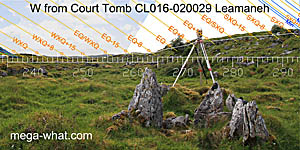 Leamaneh Court Tomb
Leamaneh Court Tomb:
Approximately equinoctial but the survey was not thorough enough for axial certainty.
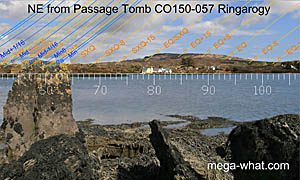
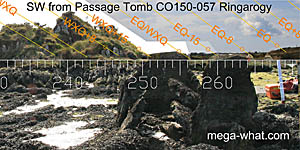 Ringarogy Passage Tomb
Ringarogy Passage Tomb:
The passage axial alignment is a half-month south of the summer cross-quarters, that's before Lughnasadh.
Axial reverse to the south-west is two to three weeks north of the winter cross-quarters, that's before Samhain.

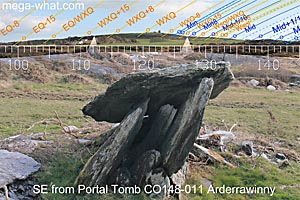 Arderrawinny Portal Tomb
Arderrawinny Portal Tomb:
Facing a cliff, the tomb axis is beyond major standstill to the north-west but the reverse seems to be towards the winter cross-quarters.
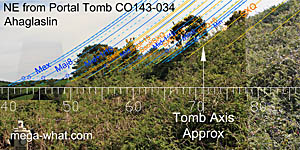
 Ahaglaslin Portal Tomb
Ahaglaslin Portal Tomb:
The portals have tilted and the capstone has swung to the north-east. The backstone and portico stones have not moved and these were used to determine that the axis
was centred at c.71° / 251°. About winter cross-quarter / equinox midpoint to the south-west and summer cross-quarter to the north-east.
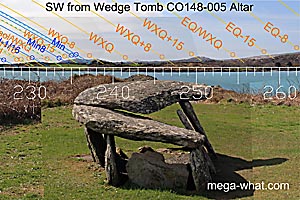
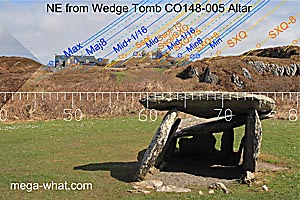 Altar Wedge Tomb
Altar Wedge Tomb:
The south-western axis covers a period of about three weeks and includes the winter cross-quarters but seemingly not any lunistices.
Axial reverse includes both minor standstill and the cross-quarters but the centre is outside the lunistice range.
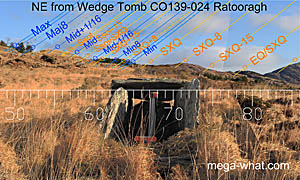
 Ratooragh Wedge Tomb
Ratooragh Wedge Tomb:
The north-eastern reverse axis is clearly towards summer cross-quarters.
The south-west axis is harder to ascertain due to the shape of the capstone but is in the general direction of winter cross-quarters.
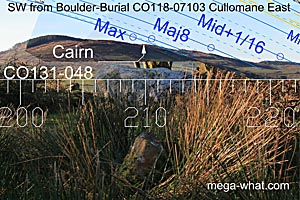
 Cullomane Boulder-Burial
Cullomane Boulder-Burial:
The line from a small outlier, through the boulder to a hilltop cairn marks major standstill but the diamond-shaped boulder indicates the south-east which is obscured.
Axial reverse indicates summer cross-quarter sunsets but the axis would be half-way between the equinox and winter cross-quarters.
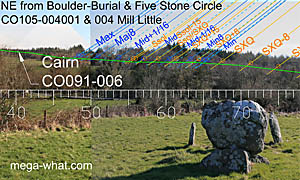
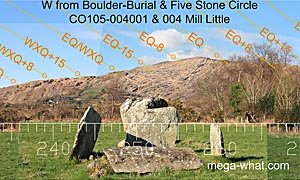 Mill Little N Boulder-Burial & Stone Circle
Mill Little N Boulder-Burial & Stone Circle:
Both boulder-burial and five stone circle indicate summer cross-quarters to the north-east. To the west they point a week or two south of the equinox (before the spring one).
The circle's radially set portals are both broken stumps and the slab across them is field clearance.
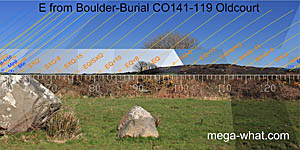
 Oldcourt Boulder-Burial
Oldcourt Boulder-Burial:
The primary boulder is displaced. Beside it is another stone, recorded as a possible fallen standing stone.
This stone clearly indicates equinox sun rises and its reverse axis to the west is close to the equinox / cross quarter midpoint.
Almost certainly a secondary boulder-burial as at
Cooradarrigan.
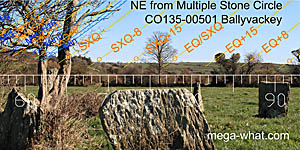
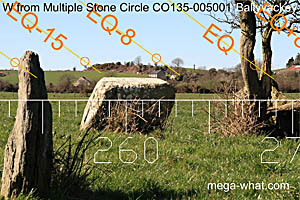 Ballyvackey Stone Circle
Ballyvackey Stone Circle:
The north portal is missing but the north-eastern axis is in the vicinity of equinox / summer cross-quarter midpoint.
The axial stone seems to span the period two to one weeks before spring equinox (after the autumn one).
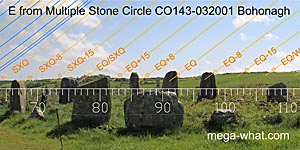
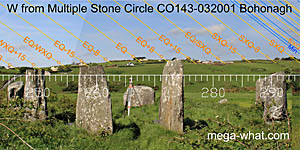 Bohonagh Stone Circle
Bohonagh Stone Circle:
The axis indicates equinox sunset. The reverse is a week or so before autumn equinox (after the spring one).

 Derreenataggart Stone Circle
Derreenataggart Stone Circle:
The south portal is a broken stump but in place. To the east, axial reverse contains the equinox and the week south of it (before spring equinox).
The western axis is centred a half-month north of the equinox (before the autumn one).
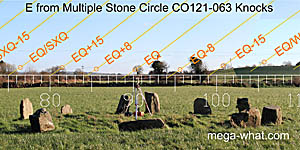
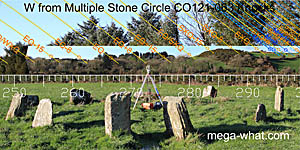 Knocks (N) Stone Circle
Knocks (N) Stone Circle:
Axial reverse clearly marks the equinox. To the west, the axis looks to be a quarter-month north of it. That is before the autumn equinox but after the spring one.

 Maulatanvally Stone Circle
Maulatanvally Stone Circle:
The north portal is missing and there is a quartzite block set within. The western axis is one to two weeks before spring equinox.
The eastern horizon is obscured but axial reverse might indicate the equinox / summer cross quarter midpoint.

 Reenascreena Stone Circle
Reenascreena Stone Circle:
The south-western axis is a week north of the winter cross-quarters and the north-eastern reverse is a week south of the summer cross-quarters.
That's before Lughnasadh and Samhain but after Imbolc and Bealtaine.
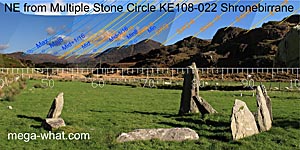
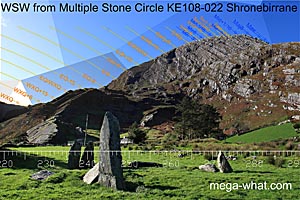 Shronebirrane Stone Circle
Shronebirrane Stone Circle:
The north portal is missing but axial reverse is towards the summer cross-quarters. Due to the high horizon, the south-western axis is half-way between equinox and summer cross-quarters.
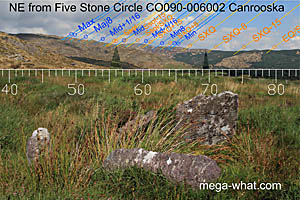
 Canrooska Stone Circle
Canrooska Stone Circle:
Built beside a stone row, sharing its position. The north portal is leaning badly & the axial stone is not perpendicular to the axis.
Seems to span a period of about a half-month north of winter cross-quarters; before Samhain, after Imbolc. The reverse is towards the minor half of the lunistice range.
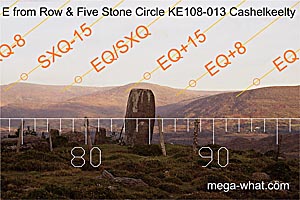
 Cashelkeelty Five Stone Circle
Cashelkeelty Five Stone Circle:
Built beside a stone row. The row axis is a half-month or so from the equinox in both directions.
The circle axis is harder to determine due to the broken portals but seems to be more equinoctial. Excavated.

 Cousane Five Stone Circle
Cousane Five Stone Circle:
The axis is more or less due east / west and spans about a week to the north of the equinox. Before Autumn equinox.
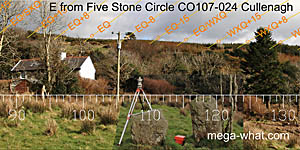
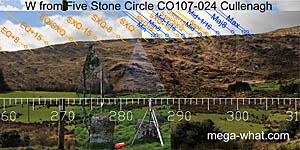 Cullenagh Stone Circle
Cullenagh Stone Circle:
Only the axial and south sidestone survive. The axis indicates summer cross-quarters. The reverse covers the half-month before spring equinox (after the autumn one).
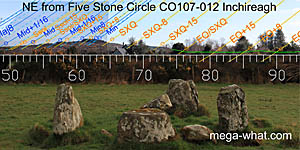
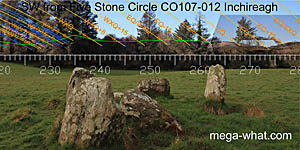 Inchireagh Stone Circle
Inchireagh Stone Circle:
The north portal has fallen but the south-western axis seems to be half-way between the equinox and the winter cross-quarters.
The north-eastern axis is a week or two south of the summer cross-quarters.

 Mill Little N Boulder-Burial & Stone Circle
Mill Little N Boulder-Burial & Stone Circle:
Both boulder-burial and five stone circle indicate summer cross-quarters to the north-east. To the west they point a week or two south of the equinox (before the spring one).
The circle's radially set portals are both broken stumps and the slab across them is field clearance.
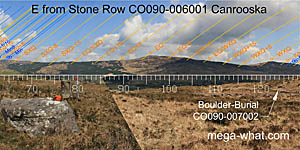
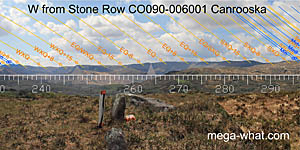 Canrooska Stone Row
Canrooska Stone Row:
The axis of this stone row is towards the equinox / cross-quarter midpoint in both directions but, also in both directions, the other side of the row is about a week to the north.
That's before Lughnasadh and Samhain, after Imbolc and Bealtaine.
Near / related to
Currakeal Stone Row.

 Cashelkeelty Stone Row
Cashelkeelty Stone Row:
Beside a five stone circle and probably built before it. Survey was from the circle. The row axis is a half-month or so from the equinox in both directions.
The circle axis is harder to determine due to the broken portals but seems to be more equinoctial. Excavated.
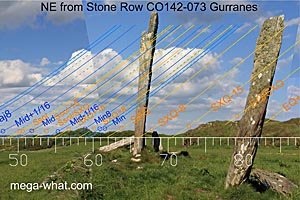
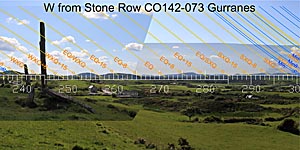 Gurranes Stone Row
Gurranes Stone Row:
The axis of the two remaining uprights of a four stone row point a little south of the summer cross-quarters and just north of the winter cross-quarters.
A fifth stone is offset, indicating the equinox / cross-quarter midpoint to the north-east but
just a little more than two weeks north of the cross-quarters to the south-west
[Pic].
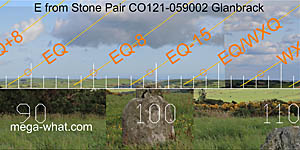
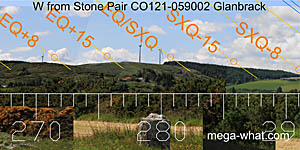 Glanbrack Stone Pair
Glanbrack Stone Pair:
Anomalous because the stones are more or less perpendicular to the row axis. Survey was primarily from the adjacent circle.
The south-eastern axis is about a half-month south of the equinox while the north-western one is possibly equinox / cross-quarter midpoint as this horizon was surveyed was from some metres further east.
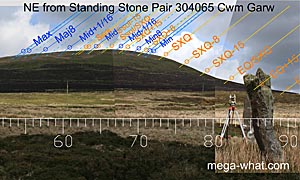
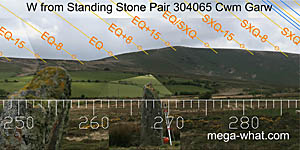 Cwm Garw Standing Stone Pair
Cwm Garw Standing Stone Pair:
The primary axis is to the north-east but the smaller stone is leaning badly. Nonetheless, it is roughly half-way between the equinox and summer cross-quarters.
To the south-west the reverse is about a week on the summer side of the equinox.

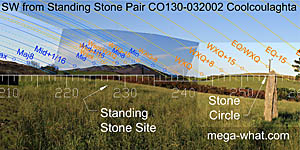 Coolcoulaghta Standing Stone Pair
Coolcoulaghta Standing Stone Pair:
Removed and then re-erected by archaeologists using a pre-existing plan.
The primary south-western axis is half-way between equinox and winter cross-quarters. The reverse is towards summer cross-quarter at the intersect of local further ground.
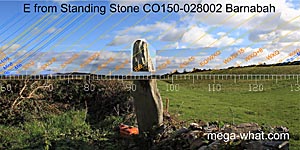
 Barnabah Standing Stone
Barnabah Standing Stone:
This stone is cup-marked and its long axis is roughly equinoctial. Perhaps a week south of it to the east and a week north of it to the west.

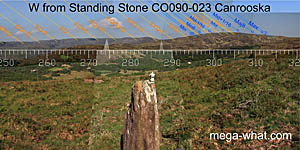 Canrooska Standing Stone
Canrooska Standing Stone:
The long axis of this stone is towards the equinox / cross-quarter midpoint in both directions. Because it is on a slope, it is easy to make it cut the eastern horizon.

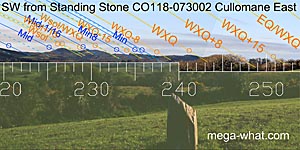 Cullomane Standing Stone
Cullomane Standing Stone
This stone (now fallen) is an outlyer of a stone circle but may have been there first as there was a series of standing stones in this area, most now gone.
Its axis was about a quarter-month south of both winter and summer cross-quarters.
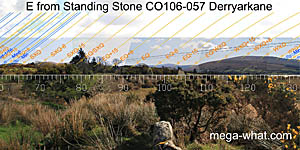
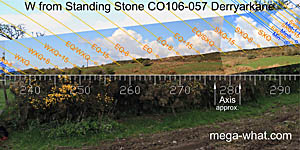 Derryarkane Standing Stone
Derryarkane Standing Stone:
This outlier of a five stone circle has an axis about 10° clockwise of east / west. To the east it points a week or so south of the equinox (before the spring one).
To the west it seems to indicate the equinox / summer cross-quarter midpoint but the sightline is obscured.
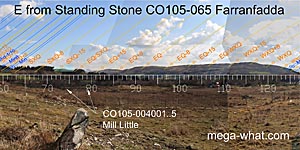
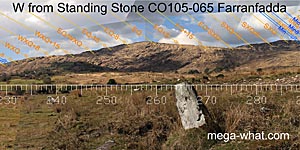 Farranfadda Standing Stone
Farranfadda Standing Stone:
This stone is leaning badly but may have been intended to indicate the equinox / cross-quarter midpoints in both directions.
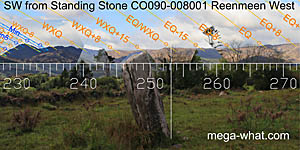
 Reenmeen Standing Stone
Reenmeen Standing Stone:
When upright this stone would have indicated the equinox / winter cross-quarter midpoint to the south-west.
To the north-east, the same edge of the stone marks the summer cross-quarters. It is quite thick and spans about a week.
Class = Solar / Lunar: Total 46 = 32%.
There are four zones, each roughly 10° wide at these latitudes, where the minor side of a
lunistice
Lunistices are the most northerly and southerly moons of the month. The lunar equivalent of solstices. More.
range overlaps with solar risings or settings.
At least one axial direction indicates one of them. If only one does so then the other may be any class. Alternatively one direction may be purely solar while the other is somewhere within a lunistice range.
Go to class= Solar |
Lunar |
Extreme |
North / South
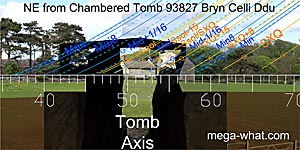
 Bryn Celli Ddu Chambered Tomb
Bryn Celli Ddu Chambered Tomb:
The passage axis is towards summer solstice sunrise. The axial reverse of c.230-235° is about half-way between winter solstice and the winter cross-quarters.
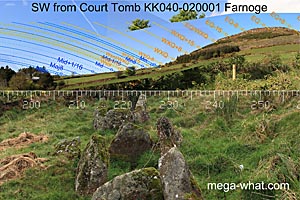
 Farnoge Court Tomb
Farnoge Court Tomb:
The axis of this long, narrow tomb indicates summer solstice to the south-west and major standstill (perhaps just beyond it) to the north-east.
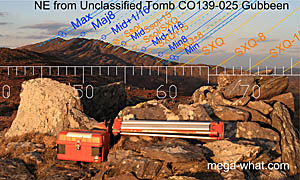
 Gubbeen Unclassified Tomb
Gubbeen Unclassified Tomb:
The chamber seems to be open at the north-east end, pointing towards the minor end of the lunistice range. The reverse axis is similar.
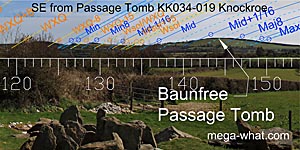
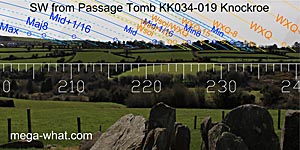 Knockroe Passage Tomb
Knockroe Passage Tomb:
There are two passages. One faces south-east and a larger, decorated one faces the south-west.
Both are said to be solstitial but clearly the eastern one is not and is in fact more likely to indicate minor standstill of the moon.
The western one is constructed such that it also seems to be centred on minor standstill but
also would allow light from the sun in right up to the winter solstice and from the moon right up to the mid-point.
[More explicit axial pics].

 Stoney Littleton Long Barrow
Stoney Littleton Long Barrow:
The passage axis is accurately centred on winter solstice sunrises. The reverse runs down the hill and dictates the orientation of the mound but is just beyond the north-western major standstill.
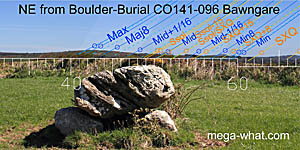
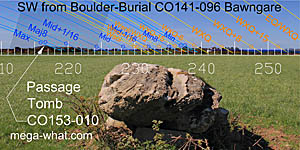 Bawngare Boulder-Burial
Bawngare Boulder-Burial:
The primary axis is to the south-west where it covers the minor half of the lunistice range. To the north-east it covers the major half.

 Kilmore Boulder-Burials
Kilmore Boulder-Burials:
This row of four boulders indicates winter solstice or lunar mid-cycle to the south-west. It is possible that standing on them once made a more distant view possible but it is now obscured.
To the north-east, the line is slightly beyond the solstice, towards a lunar sixteenth.
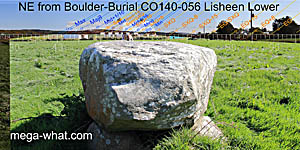
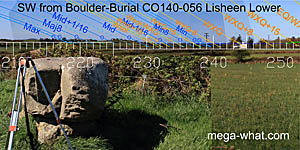 Lisheen Boulder-Burial
Lisheen Boulder-Burial:
This boulder has a long axis but the shape gives different angles. North-eastwards it centres on the minor standstill / cross-quarter. To the south-west it indicates the major standstill.

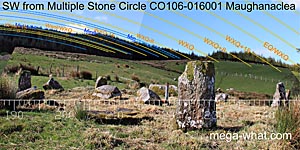 Maughanaclea Boulder-Burials
Maughanaclea Boulder-Burials:
Two boulder-burials lie within a stone circle. The central one indicates the minor side of the south-west lunistice zone.
The other, in the south-east quadrant of the circle, points to the major side of the south-east one.
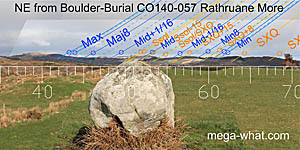
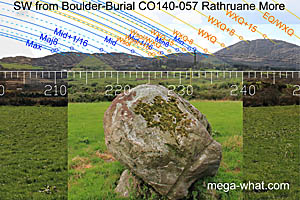 Rathruane Boulder-Burial
Rathruane Boulder-Burial:
The primary axis is to the north-east where the ridge of the boulder indicates summer solstice sun rises at a not otherwise very obvious position.
The reverse axis cannot be seen due to the slope of the ground and is not important anyway because of the prominent solstitial dip.
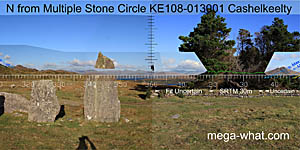
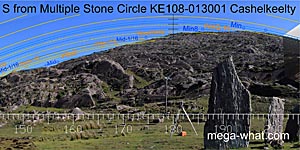 Cashelkeelty Multiple Stone Circle
Cashelkeelty Multiple Stone Circle:
Only three stones survive. Nevertheless, it seems likely that the tallest stone was a portal, thus indicating a north-south axis. Look south to see why. Excavated.

 Drombeg Stone Circle
Drombeg Stone Circle:
The south-western axial notch marks the limits of a month centred on the solstice, not the solstice itself. The reverse axis indicates major standstill to the north-east.

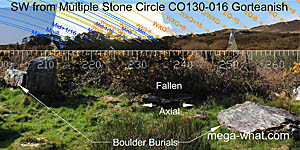 Gorteanish Stone Circle
Gorteanish Stone Circle:
Both portals have fallen. The north one inwards, the south one outwards.
The north-east axis is thus somewhere in the summer solstice to solstice / cross-quarter midpoint region while the south-west axis would seem to have indicated the vicinity of winter cross-quarters.
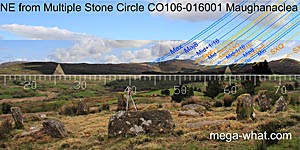
 Maughanaclea Multiple Stone Circle
Maughanaclea Multiple Stone Circle:
One portal is fallen and there are two boulder-burials within. Axial reverse is just beyond major standstill but an upright portal there might mark it.
To the south-west, the axis indicates the minor end of the lunistice range but detail is obscured.
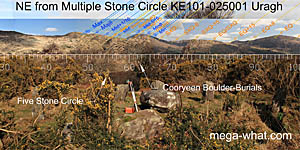
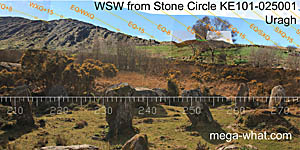 Uragh Multiple Stone Circle
Uragh Multiple Stone Circle:
The south-western axis of the circle is a half-month south of the equinox but the internal boulder-burial points to the half-month north of winter cross-quarters
[Pic].
The north-eastern axis of the circle is a half-month north of summer cross-quarters but the boulder-burial would be further north.

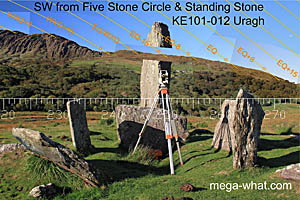 Uragh Five Stone Circle
Uragh Five Stone Circle:
Axes are confused because of monument juxtaposition. To the north-east the standing stone may indicate summer solstice but the circle axis is somewhat further south.
To the south-west the axes are two or three weeks before spring equinox.
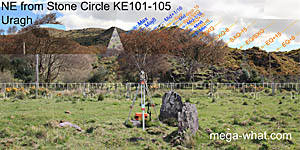
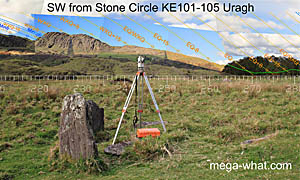 Uragh Stone Circle
Uragh Stone Circle:
This five stone circle is badly damaged but the broken stump of the axial stone seems to be in situ. To the north-east, axial reverse is towards the major end of the lunistice range.
The south-western axis indicates the equinox / winter cross-quarter midpoint.
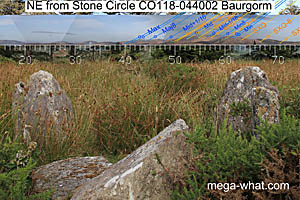
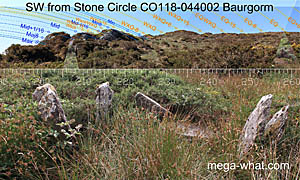 Baurgorm (E) Five Stone Circle
Baurgorm (E) Five Stone Circle:
The axial stone is unusual in having a very sloping top, the gap between the portals is uncommonly wide and the south-western horizon is very close.
Given all that, the north-east axis is towards the major end of the lunistice range while the south-west one is towards the minor end.
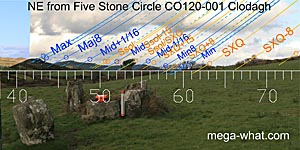
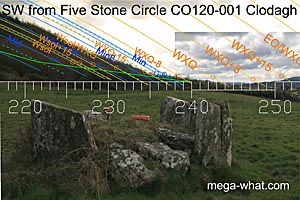 Clodagh Stone Circle & Pair
Clodagh Stone Circle & Pair:
The circle axis indicates summer solstice to the north-east and maybe solstice / equinox midpoint to the south-west.
The pair axis of c.217° indicates the limits of a month centred on winter solstice to the south-west but is beyond major standstill to the north-east.
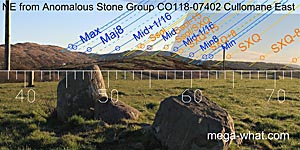
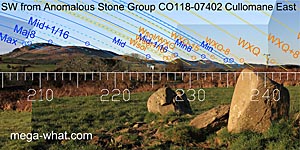 Cullomane Anomalous Stone Group
Cullomane Anomalous Stone Group:
This was probably a five-stone circle. If so then the upright stone would have been the north portal.
Given that, the north-eastern axial reverse indicated summer solstice sunrises while the south-western axis was half-way between winter solstice and winter cross-quarters.
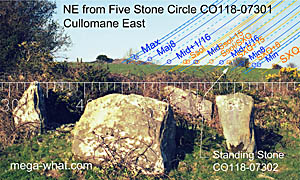
 Cullomane Five Stone Circle
Cullomane Five Stone Circle:
The circle axis indicates winter solstice sunsets while the reverse marks major standtill. The outlying standing stone (now fallen) occupies a critical position but may have been there first.
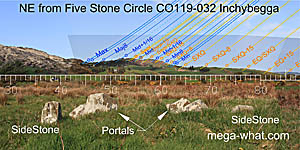
 Inchybegga Stone Circle
Inchybegga Stone Circle:
The axial stone is displaced but the north-eastern axis indicates summer solstice on a hilltop / lunar midpoint in a dip.
The south-west is obscured but the axis is towards the minor end of the lunistice range.
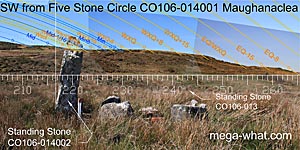
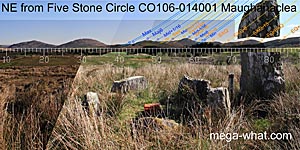 Maughanaclea Five Stone Circle
Maughanaclea Five Stone Circle:
The south-western circle axis indicates the winter cross-quarters and the adjacent standing stone marks the solstice.
Axial reverse of the circle indicates the area of summer solstice sun rises.
The stone marks major standstill
[Pic].

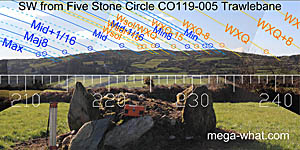 Trawlebane Stone Circle
Trawlebane Stone Circle:
The circle's south-western axis indicates lunar mid-cycle in a horizon notch. The north-eastern reverse might just include the major standstill.
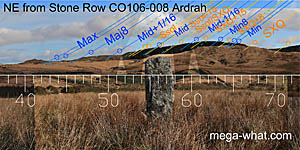
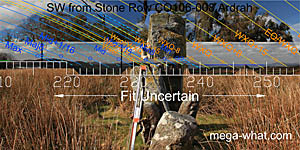 Ardrah Stone Row
Ardrah Stone Row:
Indicates summer solstice / lunar midpoint to the north-east. The tall south-west stone cuts the horizon and was perhaps intended to have winter solstice to its left and minor standstill to its right.

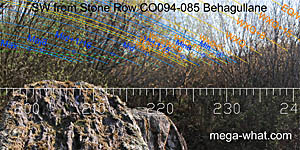 Behagullane Stone Row
Behagullane Stone Row:
The north-east axis is just beyond major standstill and two more stones should be visible in this direction but are now only broken stumps.
The south-west is obscured but the axis is approximately solstitial.

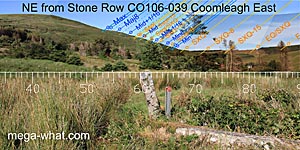 Coomleagh Stone Row
Coomleagh Stone Row:
The primary south-western axis is towards winter cross-quarters. The reverse is about half-way between summer solstice and the summer cross-quarters.
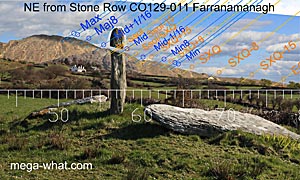
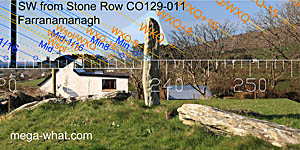 Farranamanagh Stone Row
Farranamanagh Stone Row:
Only one stone is upright. It indicates summer solstice / lunar mid-cycle to the north-east, minor standstill / winter cross-quarters to the south-west.

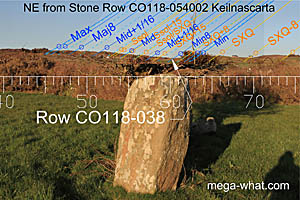 Keilnascarta Stone Row
Keilnascarta Stone Row:
The primary axis indicates minor standstill to the south-west.
The large south-west stone and fallen north-east one make accurate assessment of the axial reverse impossible but it indicates the minor half of the lunistice range.
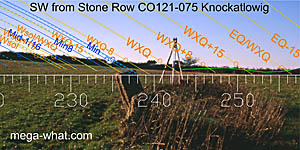
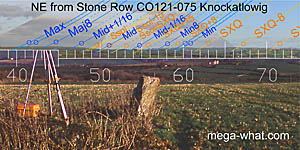 Knockatlowig Stone Row
Knockatlowig Stone Row:
The tallest, south-west, stone is fallen and the other two are leaning but the axis was perhaps into the space between minor standstill and the winter cross-quarters.
North-eastwards, the reverse is towards the middle of the minor half of the lunistice range.

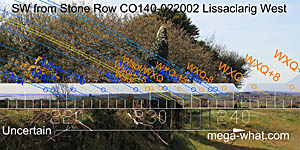 Lissaclarig Stone Row
Lissaclarig Stone Row:
The north-east stone is fallen and the western axial view is obscured. To the north-east the axis occupies the space between minor standstill and the solstice / cross-quarter midpoint.
To the south-west it seems to mark the month centred on winter solstice.
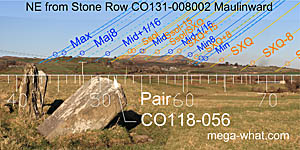
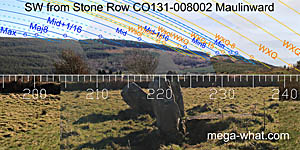 Maulinward Stone Row
Maulinward Stone Row:
The north-eastern axial line is just beyond major standstill. The south-western axis seems intended to indicate winter solstice but the stones all lean too much to be sure.
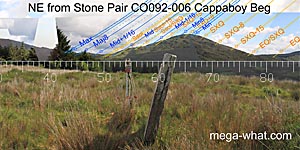
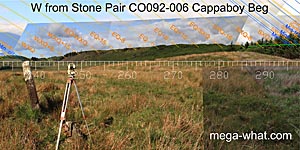 Cappaboy Standing Stone Pair
Cappaboy Standing Stone Pair:
The two stones have markedly different axes, one is a broken stub. To the north-east, the pair axis is solstitial with the western stone a half-month or so from it.
To the south-west, the western stone points towards the winter cross-quarters while the pair axis is more towards minor standstill.
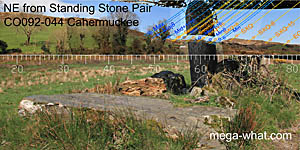
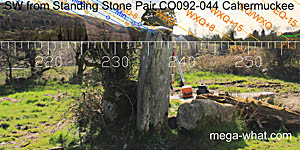 Cahermuckee Stone Pair
Cahermuckee Stone Pair:
One leaning stone remains. To the north-east it indicates the minor half of the lunistice range. To the south-west it is more towards minor standstill and the winter cross-quarters.

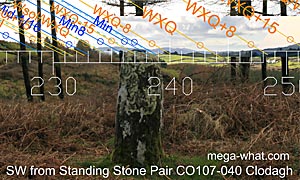 Clodagh Standing Stone Pair
Clodagh Standing Stone Pair:
The primary axis to the north-east is towards the minor half of the lunistice range, as far as the summer solstice.
The reverse indicates lunar minor standstill, which would culminate at summer solstice full moon.
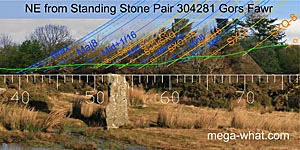
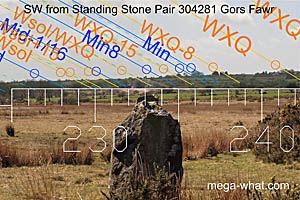 Gors Fawr Standing Stone Pair
Gors Fawr Standing Stone Pair:
The north-east axis seems to indicate lunar mid-cycle and the limits of a month centred on the solstice but could also mark the solar points to either side of that.
To the south-west it looks like the lunar minor eighth and / or the solstice / cross-quarter midpoint.

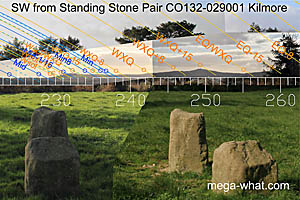 Kilmore Standing Stone Pair
Kilmore Standing Stone Pair:
The pair axis is generally solstitial in both directions but the axis of the south-west stone is radically different.
It spans the week south of the summer cross-quarters and the period one to two weeks north of the winter cross-quarters.

 Parkana Anomalous Stone Pair
Parkana Anomalous Stone Pair:
Anomalous because of the distance between them, the axis of these in-line stones is beyond major standstill to the north-east.
To the south-west they function as a sight, indicating winter solstice / lunar mid-cycle on a smooth horizon.

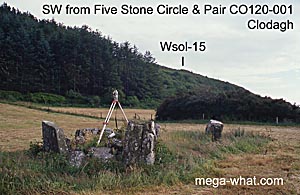 Clodagh Stone Circle & Pair
Clodagh Stone Circle & Pair:
The pair axis of c.217° indicates the limits of a month centred on winter solstice to the south-west but is beyond major standstill to the north-east.
The circle axis indicates summer solstice to the north-east and maybe solstice / equinox midpoint to the south-west.
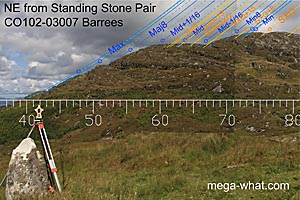
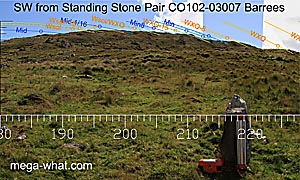 Barrees Standing Stone Pair
Barrees Standing Stone Pair:
Excavated and restored. The south-western axis indicates WXQ-8, a quarter-month south of winter cross-quarters, the solar delimiter for the lunistice range. The reverse indicates major standstill.

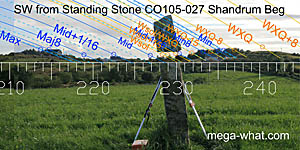 Shandrum Beg Standing Stone
Shandrum Beg Standing Stone:
Despite the lean it is clear that this stone was set so that the north-eastern long axis indicated major standstill.
To the south-west, it might have been intended for winter solstice sun sets. This stone has since fallen and been re-erected at a different angle and quite possibly not in exactly the same place.
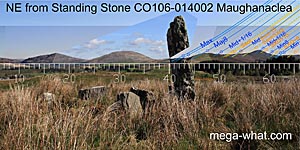
 Maughanaclea Five Stone Circle & Standing Stone
Maughanaclea Five Stone Circle & Standing Stone:
This standing stone marks major standstill to the north-east and the circle indicates the area of summer solstice sun rises
[Pic].
To the south-west the standing stone marks the solstice and the circle indicates the winter cross-quarters.
Class = Lunar: Total 40 = 27%.
Both directions indicate a pure lunar zone (major side of the
lunistice
Lunistices are the most northerly and southerly moons of the month. The lunar equivalent of solstices. More.
range) or one direction does so while the other is beyond the entire luni-solar range.
Go to class= Solar |
Solar/Lunar |
Extreme |
North / South
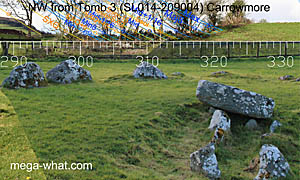
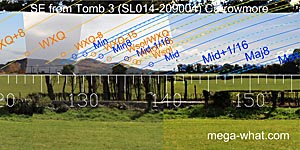 Carrowmore Passage Tomb 3
Carrowmore Passage Tomb 3:
The axis is beyond major standstill to the north-west but to the south-east it would cover the major end of the lunistice cycle.
Judging from the slope and not having seen the excavation report, it seems probable that the entrance was to the south-east.

 Deerpark Passage Tomb
Deerpark Passage Tomb:
The passage axis is centred about six degrees beyond north-western major standstill moonsets. The reverse is into the hillside but the line indicates major standstill moonrises in the south-east.
Perhaps just beyond but only just. An expression of striving to get there which is actually not uncommon...
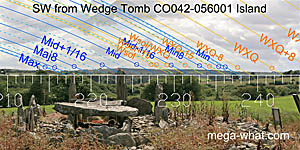
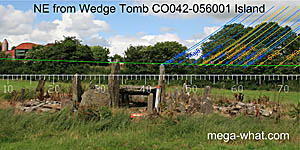 Island Wedge Tomb
Island Wedge Tomb:
The tomb faces the middle of the major half of the south-western lunistice range. The north-eastern axis is beyond major standstill.

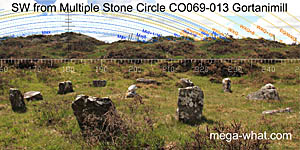 Gortanimill Stone Circle
Gortanimill Stone Circle:
The south-west horizon is very close and thus position sensitive but the circle axis clearly indicates major standstill. The axial reverse is well beyond the north-east lunar limit.
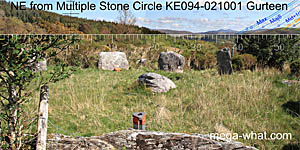
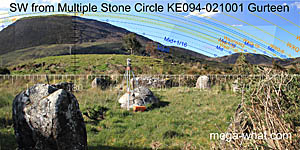 Gurteen Stone Circle
Gurteen Stone Circle:
To the south-west, the circle's axis indicates the lunar minor eighth, perhaps the sixteenth as well. The axial reverse is well beyond the north-east lunar limit.
The central boulder-burial's axis is slightly less extreme but the difference is not obviously significant.
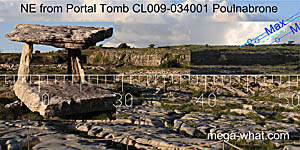
 Poulnabrone Portal Tomb
Poulnabrone Portal Tomb:
The north-eastern axis is well beyond major standstill. The (presumed) axial reverse to the south-west just includes it but might just exclude it if all the stones were in situ.
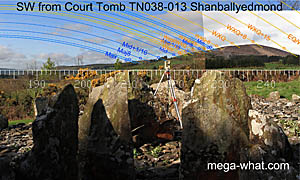
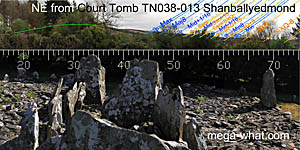 Shanballyedmond Court Tomb
Shanballyedmond Court Tomb:
The north-eastern axis is well beyond major standstill. The south-western reverse axis points at the middle of the major half of the lunistice range.
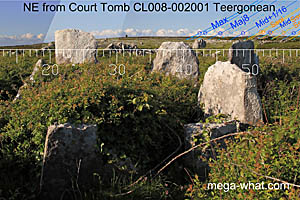
 Teergonean Court Tomb
Teergonean Court Tomb:
Given the conditions, precision is not possible but the north-eastern axis is clearly well beyond major standstill.
The south-western reverse axis seems just beyond it but with hazel scrub or similar on that piece of ground would not be.
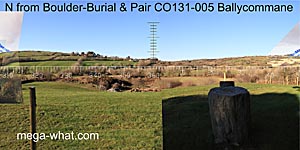
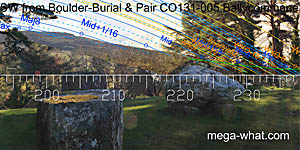 Ballycommane Stone Pair (& Boulder-Burial)
Ballycommane Stone Pair (& Boulder-Burial):
The axis of this stone pair roughly bisects the space between north and north-eastern major standstill.
To the south-west, lunar major eighth is indicated. The boulder-burial is harder to interpret but may well indicate lunar mid cycle to the south-west while being slightly beyond major standstill to the north-east.
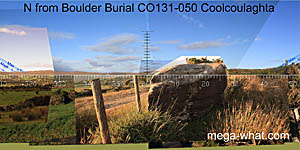
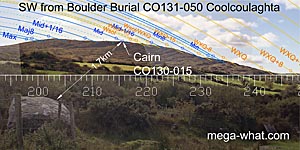 Coolcoulaghta Boulder-Burial
Coolcoulaghta Boulder-Burial:
The axis of this rectilinear boulder is towards the south-west and the major standstill.
It is well beyond that to the north-east and the ground falls sharply away so that looking over it is not possible.

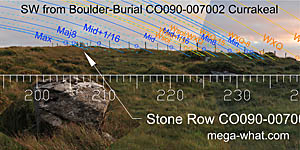 Currakeal Boulder-Burial
Currakeal Boulder-Burial:
The boulder axis indicates major standstill to the south-west at the position of Currakeal stone row. The reverse is not really a pointer and well beyond major standstill in any case.
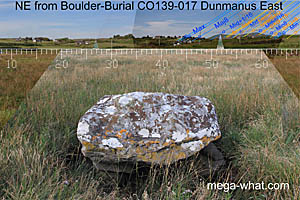
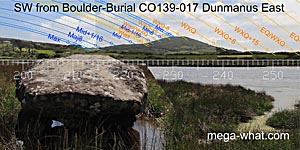 Dunmanus Boulder-Burial
Dunmanus Boulder-Burial:
The axis clearly indicates the south-west and lunar major standstill. The reverse points beyond the north-eastern lunistice range but the standstill is above the right side of the capstone.
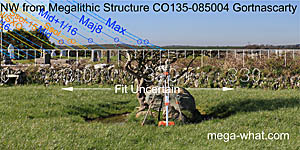
 Gortnascarty Megalithic Structure
Gortnascarty Megalithic Structure:
The long axis indicates major standstill to the north-west. To the south-east it has a broader scope, pointing at the centre of the major half of the lunistice range.

 Ahagilla Stone Circle
Ahagilla Stone Circle:
Only two stones are in situ and undamaged, the axial and south portal.
The circle axis indicates the major end of the lunistice range to the south-west but north-eastwards is slightly beyond major standstill.
This indicates that the critical axial orientation is towards the south-west.

 Drombohilly Stone Circle
Drombohilly Stone Circle:
Both radially set portals are in place though one is leaning. The tripod replaces the missing axial stone.
Axial reverse roughly bisects the space between north and north-east major standstill.
The major end of the south-western lunistice range is axially indicated but now obscured. There would have been high precision.
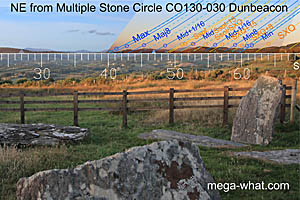
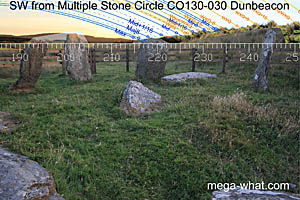 Dunbeacon Stone Circle
Dunbeacon Stone Circle:
The portals have fallen. In both directions the circle axis indicates the major end of the lunistice range if not the standstills themselves.
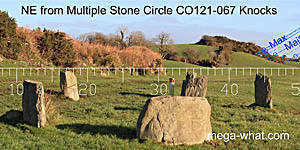
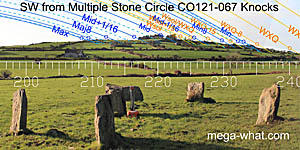 Knocks (S) Stone Circle
Knocks (S) Stone Circle:
The north portal is missing but the axis is towards the centre of the major half of the lunistice range. The reverse is well beyond major standstill.
The central monolith indicates major standstill to the south-east
[Pic].

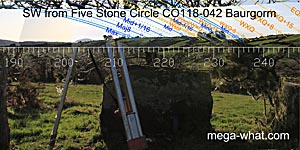 Baurgorm (W) Stone Circle
Baurgorm (W) Stone Circle:
The north portal is fallen but the axial stone clearly spans the major half of the lunsitice range. North-eastwards, the reverse would just contain the major standstill.
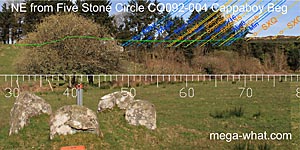
 Cappaboy Five Stone Circle
Cappaboy Five Stone Circle:
The axis seems to indicate the major end of the lunistice range to the south-west while to the north-east it is beyond the major standstill.

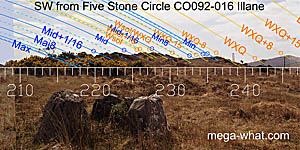 Illane Stone Circle
Illane Stone Circle:
The south-western axis is south of winter solstice and lunar mid-cycle but well within the lunistice range. The reverse is beyond major standstill.

 Kealkill Stone Circle
Kealkill Stone Circle:
The circle axis indicates major standstill to the north-east and lunar major eighth to the south-west. The large portal is set east west and creates a north-south secondary axis.
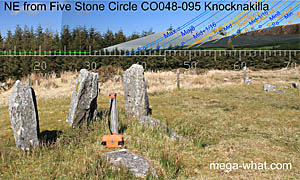
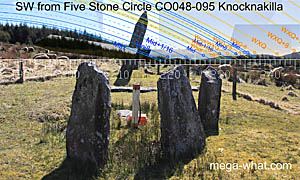 Knocknakilla Stone Circle
Knocknakilla Stone Circle:
The circle axis indicates major standstill to the south-west, the reverse is beyond it. It looks like the standing stone pair, which was probably there first, was the same.
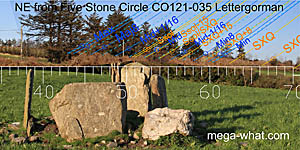
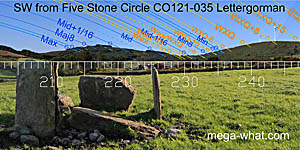 Lettergorman Stone Circle
Lettergorman Stone Circle:
The north portal is fallen. Axial reverse to the north-east indicates the major end of the lunistice range. The south-western axis points towards the centre of the major half of it.

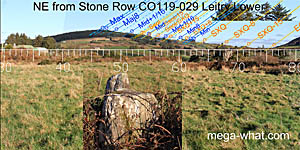 Leitry Lower Stone Row
Leitry Lower Stone Row:
The south-western axis seems to be towards the centre of the lunistice range.
The north-eastern stone, the same height as the SW one, is leaning badly and cannot be seen here but the axis in that direction is perhaps towards the lunar major eighth.
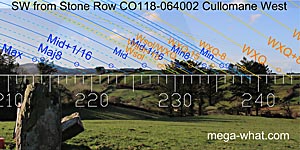
 Cullomane Stone Row
Cullomane Stone Row:
This axis indicates major standstill to the south-west but is well beyond it to the north-east.
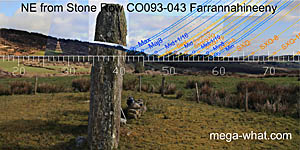
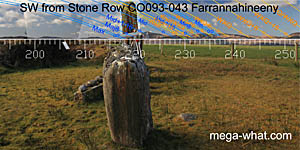 Farrannahineeny Stone Row
Farrannahineeny Stone Row:
This five stone row indicates major standstill in both directions but greater subtleties may have been possible to the south-west.

 Scartbaun Stone Row
Scartbaun Stone Row:
Axial reverse is beyond the north-eastern major standstill. The south-western axis indicates the middle of the major half of the lunistice range.
The intention was clearly lunar but these last two could be classed as extreme.
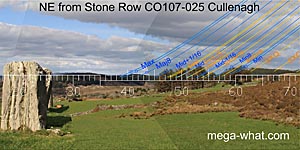
 Cullenagh Stone Row
Cullenagh Stone Row:
Built at the eastern side of the top of a rise. The north-eastern reverse axis is well beyond the major standstill.
To the south-west, the slope allows fine precision for major standstills.
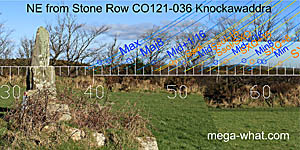
 Knockawaddra Stone Row
Knockawaddra Stone Row:
The overall axis is beyond the major standstills in both directions but both the tall north-east stone and the smaller south-west one are angled so that they do indicate them.
Was there forest on the south-western horizon when it was built?

 Ballycommane Stone Pair (& Boulder-Burial)
Ballycommane Stone Pair (& Boulder-Burial):
The axis of this stone pair roughly bisects the space between north and north-eastern major standstill.
To the south-west, lunar major eighth is indicated. The boulder-burial is harder to interpret but may well indicate lunar mid cycle to the south-west while being slightly beyond major standstill to the north-east.

 Knocknakilla Stone Pair
Knocknakilla Stone Pair:
The circle axis indicates major standstill to the south-west, the reverse is beyond it.
It looks like the standing stone pair, which was probably there first, was essentially the same but one stone is fallen and the other is leaning.

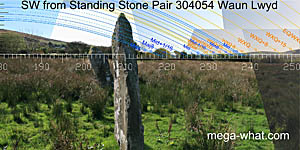 Waun Lwyd Standing Stone Pair
Waun Lwyd Standing Stone Pair:
The south-western axis is a few degrees beyond major standstill. The north-eastern one is well beyond it but compensate for the leaning stone and it might be somewhere close to bisecting the space.
Dolaumaen Standing Stone is visible on the south-eastern horizon in a significant position.
[Pic]
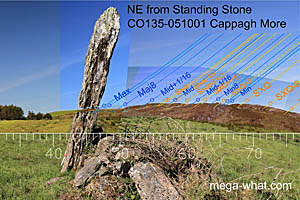
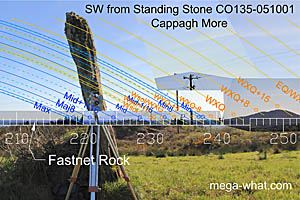 Cappagh More Standing Stone
Cappagh More Standing Stone:
One of two stones (the other fallen) 30m apart, with a combined NW/SE axis.
This one is slightly beyond major standstill to the north-east, maybe the sixteenth on the major side of mid-cycle to the south-west.
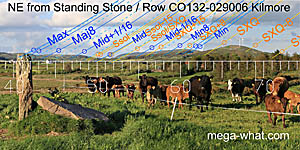
 Kilmore Stone Row
Kilmore Stone Row:
Listed as a standing stone as it was buried in a bank when catalogued. The one stone that was visible then remains upright and indicates major standstill to the north-east.
The south-west axis (c.221°) was not surveyed but the view would be almost identical to that from the adjacent boulder-burials.
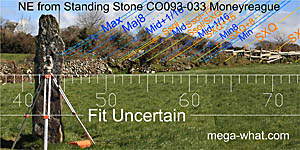
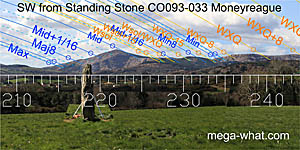 Moneyreague Standing Stone
Moneyreague Standing Stone:
The long axis is just beyond major standstill to the north-east but points to the middle of the major half of the south-western lunistice range.
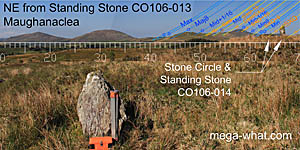
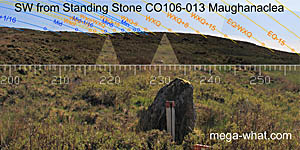 Maughanaclea Standing Stone
Maughanaclea Standing Stone:
The north-eastern axis is well beyond major standstill.
The south-west is harder to determine. A strict reverse axis c.210° would be lunar but the shape could indicate the winter cross-quarters.
The line between the two standing stones could be said to indicate the summer cross-quarters.
Class = Extreme: Total 15 = 11%. Both directions indicate horizons beyond the luni-solar range and neither point north-south.
Go to class= Solar |
Solar/Lunar |
Lunar |
North / South

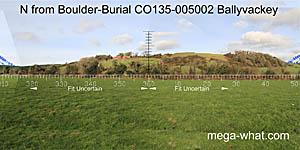 Ballyvackey Boulder-Burial
Ballyvackey Boulder-Burial:
Listed as a possible boulder-burial this one has a small standing stone at its northern end.
The long axis roughly bisects the space between south-eastern major standstill and south. Similarly to the north-west.
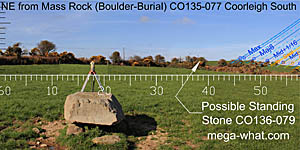
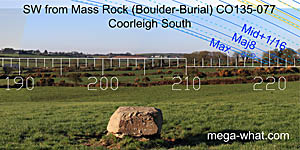 Coorleigh South Boulder-Burial / Mass Rock
Coorleigh South Boulder-Burial / Mass Rock:
The flat top is decorated with two prominent transverse grooves delimiting a central area containing perhaps thirteen cupmarks
[Pic].
The north-east axis roughly bisects the space between north and north-eastern major standstill. The south-western one is closer to the standstill.
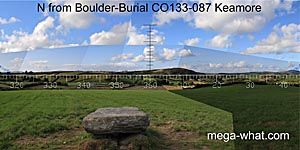
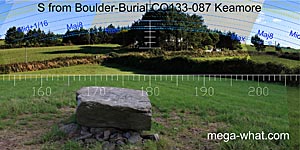 Keamore Boulder-Burial
Keamore Boulder-Burial:
The axis is about 10° anti-clockwise from north-south which roughly bisects the space between south-east major standstill and due south.
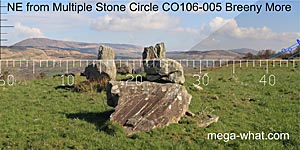
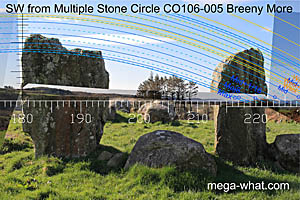 Breeny More Stone Circle & Boulder-Burials
Breeny More Stone Circle & Boulder-Burials:
The north-east / south-west axes of the circle and the rectangular arrangement of four boulder-burials are both extreme ones.
The circle roughly bisects the space between north /south and the major standstills. The boulder-burials are less extreme.
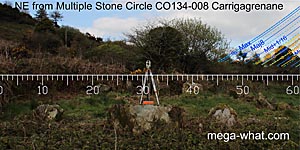
 Carrigagrenane Multiple Stone Circle
Carrigagrenane Multiple Stone Circle:
This is a complex circle with a fallen central monolith and radially set portals with an extra pair of stones outside them.
The axis is just beyond major standstill to the south-west, well beyond it to the north-east.
Moving one space clockwise from the portal gap changes things radically
[Pic].
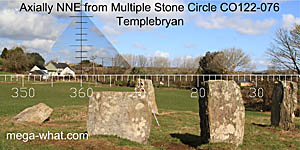
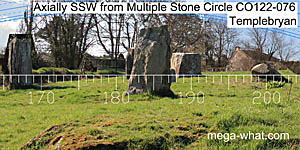 Templebryan Stone Circle
Templebryan Stone Circle:
The presumed north portal is missing and there is a central monolith that indicates north-south exactly.
The circle's axial alignment is something less than 10° clockwise of that and it is not easy to understand why.
Perhaps because the south-east horizon is better than the south-west one?
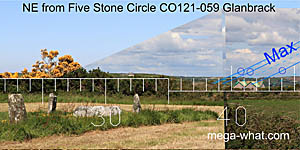
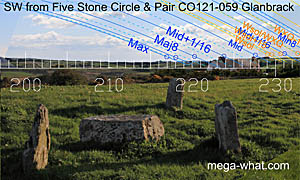 Glanbrack Stone Circle & Pair
Glanbrack Stone Circle & Pair:
The circle's portal stones are missing but the axis is about 10° beyond north-east major standstill, not quite so far beyond the south-west one.
The south-eastern axis of the anomalous pair is about a half-month south of the equinox while the north-west one is a few days more to the north of it.
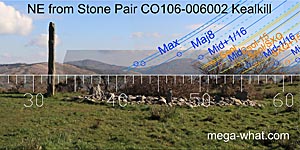
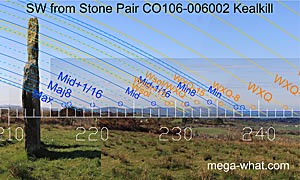 Kealkill Stone Pair
Kealkill Stone Pair:
The axis is beyond major standstill in both directions, though only just so to the south-west.
Also bear in mind that these axial pics of the row have been applied to horizons surveyed from the circle which is a few metres further north.

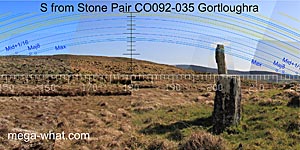 Gortloughra Stone Pair
Gortloughra Stone Pair:
The pair axis is about 20° clockwise of north-south, which roughly bisects the spaces between north-south and the major standstills in both directions.
The smaller stone is set so that it indicates significant events in all four directions.

 Kilcrohane Standing Stone Pair
Kilcrohane Standing Stone Pair:
The larger stone is to the north-east and the pair axis is about 13° clockwise of north-south. It is a good bit further than that from the major standstills but more so to the north.
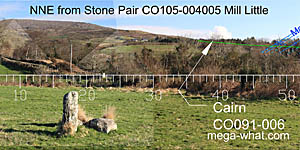
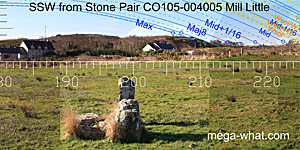 Mill Little Standing Stone Pair
Mill Little Standing Stone Pair:
The stones are in-line and the axis is about 18° clockwise of north-south.
This less than bisects the space between north and the major standstill but more than bisects the space between south and the major standstill.
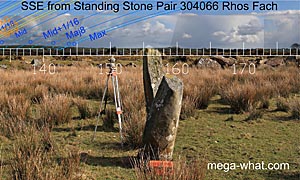
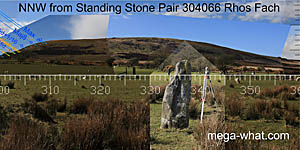 Rhos Fach Standing Stone Pair
Rhos Fach Standing Stone Pair:
These two are leaning and there may once have been a third. The north-west axial alignment roughly bisects the space between north and major standstill.
The south-eastern line is closer to the standstill. The southern stone's axis indicates north-east major standstill
[Pic].
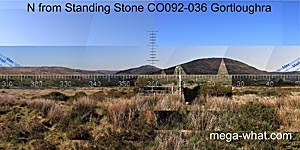
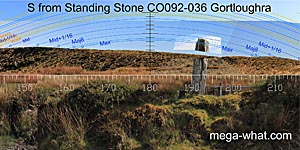 Gortloughra Standing Stone
Gortloughra Standing Stone:
The long axis is 10° or so clockwise of north-south, which roughly bisects the space between south and the south-western major standstill.





















































